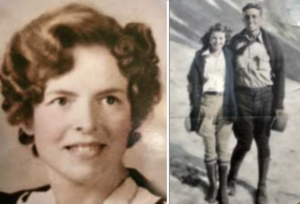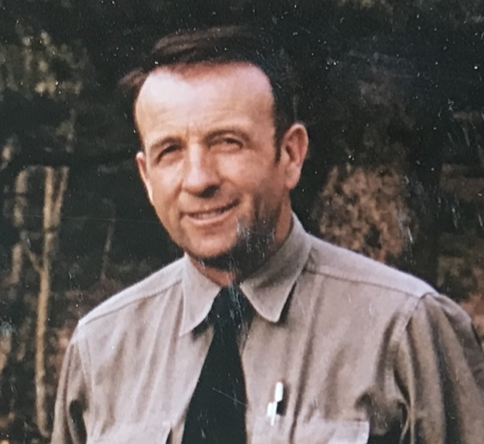The Lone Ranger of the Manti-La Sal Forest was my idol. My father, Julian Thomas, spent most of his life in a green khaki shirt, proudly wearing a forest service pin. His job was to keep the mountains from eroding under the pounding of heavy spring rains. He was also assigned to help coax life back into depleted grazing lands and, in the spring, he determined the number of cattle and other livestock that would be allowed in the forest to graze. And whenever it was needed, Dad was ready to hand out advice, wisdom, and encouragement to the other rangers on the million-acre parcel of forest under his jurisdiction. His welcome words were also readily available to my brothers and me. We were always tagalong observers on his trips into the forest or onto the range. Sometimes the back of a pickup truck was our chariot into the world Mother Nature had created for us; other times horses carried us on our journey into the wild. Some of my most precious memories of my father are of the days I spent bouncing along by his side in the green forestry truck, surveying the mountains. When we weren’t hauling any equipment, I was allowed to view the fabulous vantage point from the hayrack fastened over the truck’s cab. I can still remember the wind blowing my long braids behind me while I grabbed leaves from passing trees.
Dad used these special times to teach me important lessons about life. Once, after a long horseback ride, he asked if I could find my way back home. I had been too absorbed in viewing the scenery and enjoying the fun of the day to pay any attention to where we were going, so I had no idea how to get back.
“Before you leave home,” Dad imparted, “always look around the mountains and get an idea of where you are. Find a landmark and get well in mind where you are so you can always find your way back.”
His advice has served me well. I’ve visited hundreds of cities where there weren’t always mountains to direct my path. But I’ve learned that all you need is one landmark to anchor yourself. If you know who you are and where you’re going, you’ll always be able to get back.
I credit my father with my love of the outdoors. But it was my mother, Norene, who fostered my innate creativity. Part of the reason Mother relied on ingenuity so strongly was due to the reality that we lived a hundred miles from the nearest big city. I remember Mother collecting honeycombs, then melting them down and separating the honey. I also remember watching her make homemade soap and root beer. She milked our cows. Although we didn’t have a store down the street to buy anything we wanted, we did have the world at our fingertips, and she made sure we used it.

Mother would not have dreamed of buying a ready-made Halloween costume. So, in October, she would hand us kids a stack of old Children’s Friend magazines.
“Look through the pictures and find something you like,” she’d tell us. “But you can’t use anything the way it appears. Instead, she said, we could combine ideas from more than one costume to make a truly unique and interesting outfit. With the excitement that overtakes most kids in planning the best costume ever, my brothers and I would pore over the magazines for hours. Then we’d discuss what exactly we’d come up with. Almost always, one of us won an award for our work. One year, my brother Jared spent hours painstakingly constructing a fat man costume. Another time, he won an award for impersonating a skunk.
Food
If organic, free-range, and homegrown were descriptions of healthy food, we had all of that and more. Both Mother and Dad were raised during the Depression. Life, when they grew up, was a challenge if they did not grow their food. Not only did they grow it, but they knew how to can it and store it away for the cold winters.
We always raised our chickens and beef. Hence, we learned how to eat a lot of items that you do not see in the store. I remember eating tongue, heart, liver, and gizzard. When it came time for a cow to be prepared to be eaten, they were taken to the butcher shop in town and cut up into edible portions.
When the old chickens stopped laying eggs and were ready for us to eat them, my dad heated a huge pot of water. The heads of the chicken were then cut off. Often the chickens ran around without their heads. They soon fell to the ground dead. We then put them in the boiling hot water. After that, we took them out of the water and pulled their feathers out. They were then cleaned and prepared for the freezer.
Often, we had two big gardens. We were expected to work in the garden to help prepare our food. We grew everything from corn on the cob to beets, radishes, lettuce, carrots, and cucumbers. We had fresh vegetables all summer. Then the items that could be canned were bottled and put down in the cellar for the winter. We had a room in the basement that was filled with bottled items. We would also buy peaches, pears, and apples and bottle them.
Whole wheat bread was our everyday staple. My mother ground the wheat and then made the bread. We often helped her knead the bread to develop the gluten, which is an important step in preparing the bread. The coarse ground wheat was used to make morning mush.
Fresh eggs were gathered every day, even in the winter. We also got milk from our cow every day.
I do not think there was another way to have a healthier diet. We contracted some of childhood diseases, but basically, we were all very healthy. I don’t remember any of us being allergic to anything.

